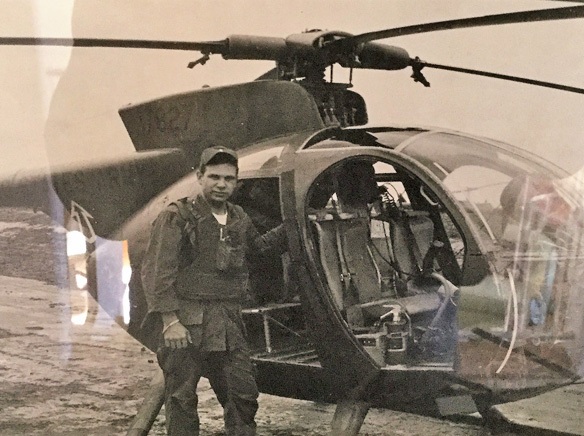As told to Michael H Pazeian.
Second of two parts.
Born in 1943, I grew up in Dayton, Ohio next to Wright-Patterson Air Force Base, I always wanted to be a pilot. The Army had a Warrant Officer rank which allowed you to fly without a college degree. After three years of college, I got my draft letter. I went to my recruiter and joined the Army for the Warrant Officer Fight Program.
In December 1967 and after many months of basic, flight, officer, and survival training I graduated from the Warrant Officers Candidate Flight school and got my wings. I now had three years to serve on active duty.
On January 31,1968 we arrive in Vietnam. I was assigned to the 269th Combat Aviation Battalion, the 116th Assault Helicopter Company – the Hornets, in Cu Chi. I was almost 25 yrs. old, one of the oldest guys.
Very early on in-country, I was shot down twice. And I got used to the routine. We would use the same landing zones to drop off the soldiers. It was hard to realize that even when getting shot at we would fly back to the same area. As I sat in the pilot seat during one mission I watched one of our F-4s drop a bomb on Viet Cong positions. We took off, I said what’s next? And was told we go pick up six more of our soldiers to bring them to the same LZ.
Being under fire so often influenced me. Early on I just gave up. I was not like the other guys. I stopped keeping a flight log. I did not buy stereo equipment, a camera, or more. I thought they were going to kill my ass. I quit. I stopped worrying about later and focused on just my job that day. After coming home, I was in counseling at Vet centers for years. I realized during counseling that my giving up over there—helped me survive.
Helicopter mobility started to be used in Vietnam in 1962. Using helicopters as an air assault, multiple UH-1, to fire on the enemy, bring soldiers into the battle, and retrieve them was a new concept for the Vietnam war. An assault helicopter company was 310 guys, only 56 saw the fighting. All others were supporting the company. A mission was 10 “slicks” and 4 gunships. The “slicks”, UH-1 Huey, carried the soldiers. The troop level in 1960 was 900 advisors, but by 1969, the height, was 549,500. What most people don’t know, only 1 of 7 were actually in combat, fighting. Most were there in supporting roles.
There were 25,000 men at Cu Chi, the headquarters for the 25th Infantry Division. The 310 guys of the 116th Assault Helicopter Company were assigned to support the 25th infantry. So, the Hornets took them anywhere they were assigned to go. We did combat assaults, combat insertions, combat extractions, and emergency resupplies. We would fly medivac, grave registrations, and regular supply. We would refuel as the engines were running. One time I logged 19 hours in one day. I made aircraft commander after 300 hours of flying in-country. I picked Hornet 1-7 as my call sign. I had been in-country about five months.
After eight months I put in for an extension. I did not want to go back to the States to be an instructor for 18 months, then have to return to Vietnam for six months. The extension allowed me to do all my combat time at once. I got my extension but was transferred at the same time. I had to go to the 25th Aviation Company in Long Binh. A special air service was created to use Hughes OH-6 Cayuse (Loach) for Allied units who did not have Helicopters support. I transitioned into the Loach after 10 hours flight time. This special group provide air support to allied groups and individuals who did not have their own OH-6 helicopters in-country. The First Australian Task Force, Fifth ARVN Rangers, John Paul Vann head of CORDS, and Free World Forces were all included.
I was first assigned to fly the Australians. Each morning I got my assignment for the day. I flew individuals and groups wherever they needed to go.
John Paul Vann had had a very colorful career by 1968: Army Air Corp 1943, 2nd LT but did not see action, 8th Range Company in Korea, and as a Lt. Colonel he goes to Vietnam for the first time in 1962. His written reports about the war in Vietnam became very controversial. During 1963 Vann left the Army.
By 1968 Vann was back in Vietnam to serve as Deputy for Civil Operations and Rural Development Support CORDS III (i.e., commander of all civilian and military advisers in the Third Corps Tactical Zone). In November 1968 when he was assigned to the same position in IV Corps, which consisted of the provinces south of Saigon in the Mekong Delta.(see “A Bright Shining Lie: John Paul Vann and America in Vietnam” (1988) by Neil Sheehan).
Vann’s regular pilot was not available for a few days, so I flew him everywhere he wanted to go. He lived in a villa at Ben Hoa, and as his pilot I was on call 24/7.
Flying a recon mission with the Senior American Advisor, we found a large weapons cache buried along a channel outside Saigon which was to be used to arm the Viet Cong and NVA troops during the planned ’69 TET Offensive. I was awarded the Vietnamese Ranger Badge.
Lt. General Julian Ewell took command of II Field Force Vietnam. That’s when I was “drafted” to be his pilot and Aircraft Commander. The picture of President Thieu was taken in General Ewell’s personal aircraft a UH-1H. I landed the helicopter on the front lawn of the Presidential Palace in Saigon to pick up the president of Vietnam and fly over the parts of the local countryside he wanted to see.General Ewell wanted to visit the 11th Armored Cavalry Regiment at Xuan Loc Vietnam (approximately 70km east of Bien Hoa). The UH-1H was a new ship with about 400 flight hours. Returning to II Field Force-Vietnam Headquarters at Long Binh, we noticed a smell and noises coming from the engine compartment, within minutes, all the Warning Lights came on and there was a sharp “snap” to the cyclic control, indicating a complete hydraulic system failure. We had practiced this emergency procedure since first transitioning into the Huey.
The Emergency Procedure was to reduce airspeed to 60 knots. This was going to be a problem since we were about 60km away from the base and would take 40-50 minutes to fly back with no control and there was no other airfield around. The other problem was that we can’t land like a helicopter, we must make a 6-degree approach to the runway and then “slide” the helicopter along the runway. The biggest problem is that at any time the cyclic control can completely seize up and there is NOTHING you can do except crash. I notified my company and the General about the situation and after flying for about 40 minutes made an emergency landing at Long Binh. (See Letter, which is dated 12/19/1968)
Shortly after this event, I rotated home in early 1969.




